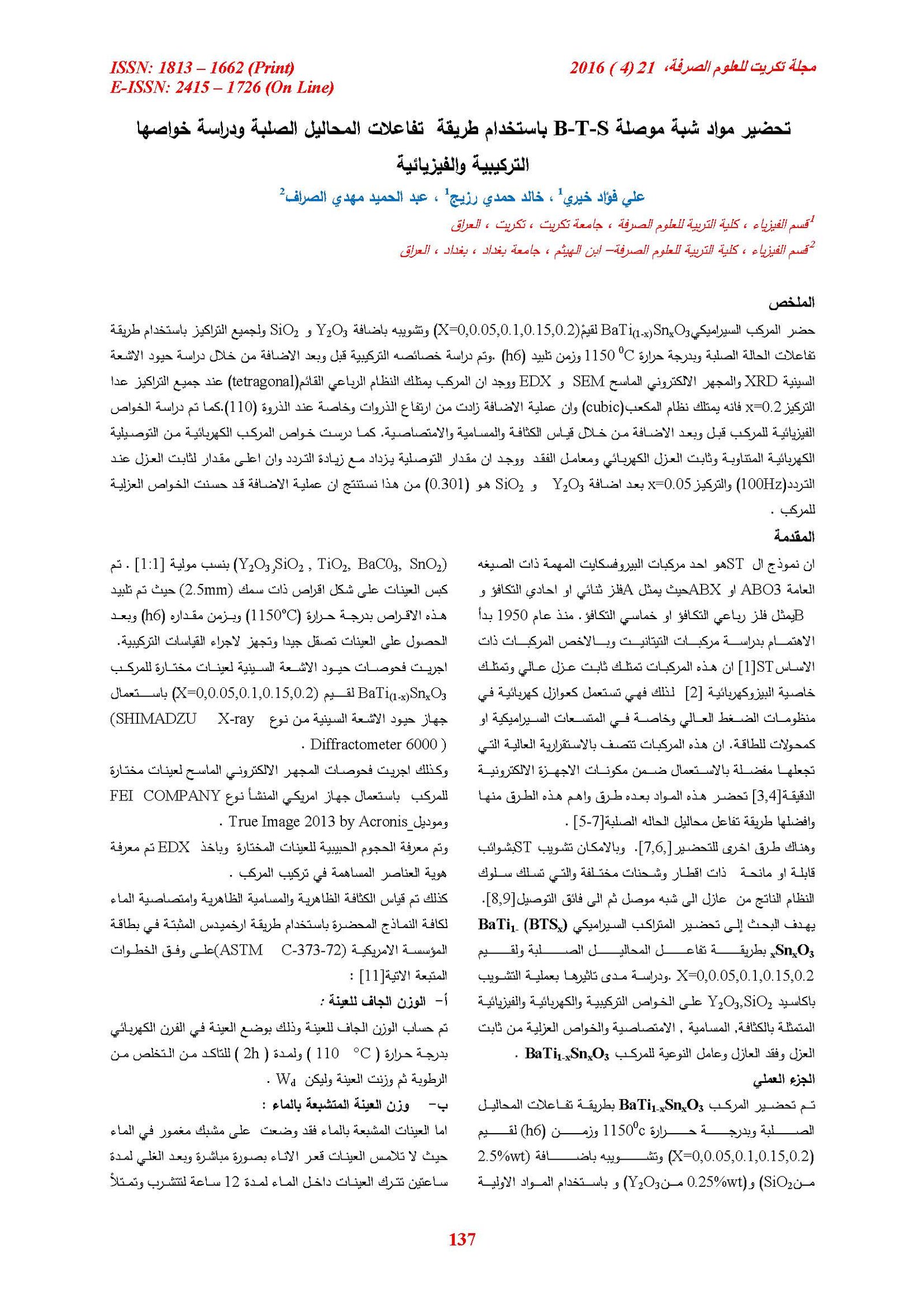PREPARATION OF B-T-S SEMICONDUCTORS BY USING SOLID STATE REACTION AND STUDYING ITS STRUCTURAL AND PHYSICAL PROPERTIES
Main Article Content
Abstract
In this study, the ceramic compound BaTi(1-x)SnxO3 was prepared at (x=0, 0.05, 0.1, 0.15, 0.2) and doped with SiO2 and Y2O3 for all concentrations by using solid state reaction at 1150 oC and sintering time of 6h. Structural properties were studied before and after adding SiO2 and Y2O3 by using X-ray Diffraction (XRD), Scanning Electron Microscopy (SEM) and Energy dispersive X-ray (EDX). It is found that the compound BaTi(1-x)SnxO3 has tetragonal structure for all concentration except at (x=0.2) which has cubic structure. After adding SiO2 and Y2O3, the peaks height was increased especially at (110).
Physical properties were studied before and after adding SiO2 and Y2O3 by measuring density, porosity and absorbency. It is found that the density was increased while the porosity and absorbency were decreased as concentration increased.
The electrical properties were studied such as alternate electric conductivity, dielectric constant and dielectric loss coefficient. It is found that the alternate electric conductivity was increased as frequency increased and the highest value of dielectric constant at frequency (100 Hz) and (x=0.05) after adding SiO2 and Y2O3 was (0.301). It is clear that the adding of SiO2 and Y2O3 enhanced the dielectric properties of BaTi(1-x)SnxO3.
Article Details

This work is licensed under a Creative Commons Attribution 4.0 International License.
Tikrit Journal of Pure Science is licensed under the Creative Commons Attribution 4.0 International License, which allows users to copy, create extracts, abstracts, and new works from the article, alter and revise the article, and make commercial use of the article (including reuse and/or resale of the article by commercial entities), provided the user gives appropriate credit (with a link to the formal publication through the relevant DOI), provides a link to the license, indicates if changes were made, and the licensor is not represented as endorsing the use made of the work. The authors hold the copyright for their published work on the Tikrit J. Pure Sci. website, while Tikrit J. Pure Sci. is responsible for appreciate citation of their work, which is released under CC-BY-4.0, enabling the unrestricted use, distribution, and reproduction of an article in any medium, provided that the original work is properly cited.
References
1. J.Hulm,Proc.Phy.Soc.vol,A63(1950) p.p.1184.
2. B. Jaffe, W. Cook "piezoelectric Ceramics
Academic Prees, New York, NY, (1972) .
3. C. Ming, J. Karl. "Fundamental research needs in
ceramic". NSF Work Shop report, (1999).
4. P. Sukon, H.B. Robert, "CMU. Journal", Vol.3,
No.2 (2004).
5.A. Wold, K. Dwight, J. Sold State Chem. vol,88
(1990). p.p.229-238.
6.G.Pfaff,F.Schmidt,W.Ludwing,J.Thermal,vol.
33,(1988). p.p771-779.
7.K.Kudaka,K.Hzumi,Am.Cera. Soc. Bull., vol. 61,
(1982) .p.p1236-1240.
8. I. Burn and S. Neirman, J, Master. Sci., vol., 17
(1982). pp3510.
9. W.B. Michel, "Fundamentals of ceramics", 1st
edition, Mc. Grow-Hill
10- C. Elissalde, and J. Ravez, "Ferroelectric
ceramics: defect and dielectric relaxation "J. Mater.
Chem., Vol. 11, (2001) 1957-1967.
11- ASTM , C20-18T ,Standard test method for water
absorption, Bulk density , apparent porosity and
specific gravity of fried white wave products .
12.Hema Chandra Rao Bitra and B.B.V.S Vara
Prasad. Internatianal Letters of Chemisitry, Physics
and Astronomay. Vol.,13.(2014). p.p191-201.
13- H.P. Chen., T.Y. Tseng, "J. Mater. Sci. Lett.
"Vol.8 (1991)
14- Alice C. De Bellis, M.Sc. Thesis, "University of
Pittsburgh" (2002).
15- W.D. Kinger, H.K. Bowden, D.R. Uhlmann,
"Introduction to ceramic" Second ed., John Wiley and
Sons. (1976).
16- X. Du., I.W. Chen, "J.Am. Ceram. Soc." Vol.81
(1998) P 3253.
